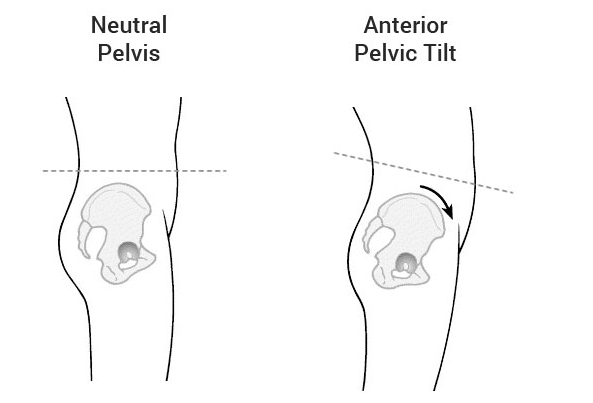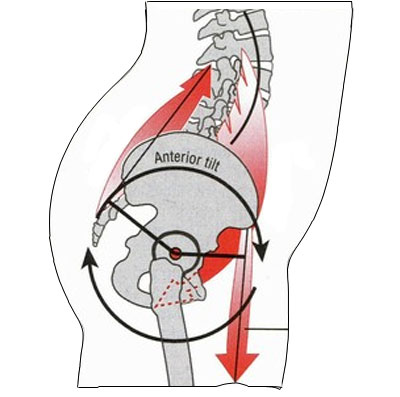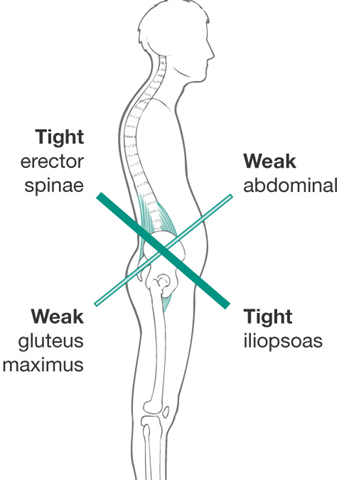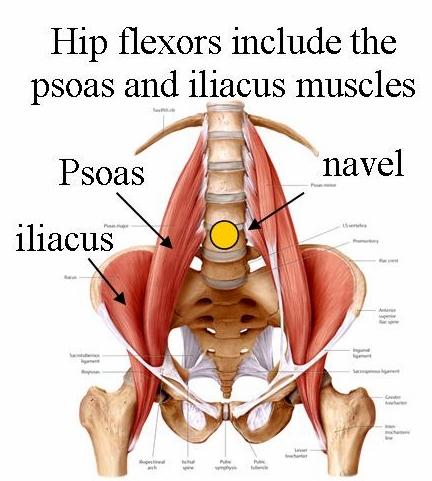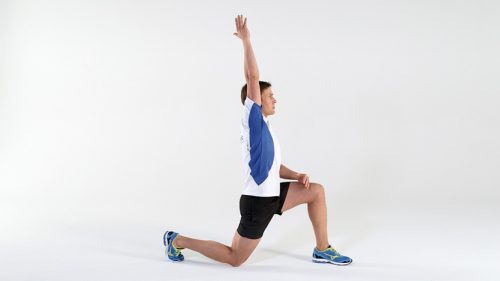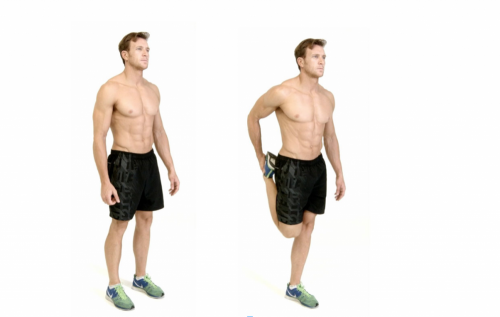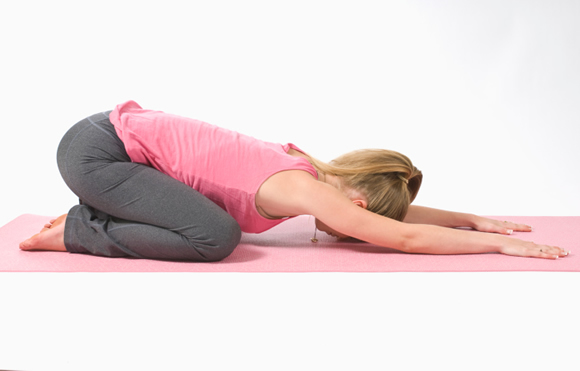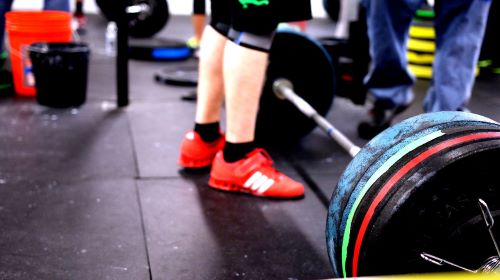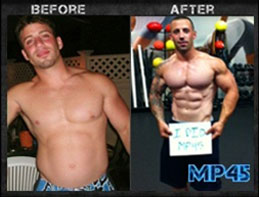The anterior pelvic tilt is probably the most common problem when it comes to people’s posture.
It can make both your gut and butt protrude and it can also be accompanied by pain particularly in the lower back when standing for too long or walking longer distances.
Here’s the kicker:
If you don’t do anything about it there is almost no chance of it going away and could get even worse.
Luckily there are things you can do to reverse this problem and return your posture to normal and also relieve that back pain.
In this article, we will go over the right stretches and exercises that will fix your anterior pelvic tilt.
Related: How I Fixed My Lifter’s Elbow
What is an Anterior Pelvic Tilt?
The pelvic tilt refers to the orientation of the pelvis in respect to the rest of the body and the thighbone. There are different pelvic tilt conditions an individual can suffer but let’s focus on the anterior pelvic tilt.
The anterior pelvic tilt refers to a situation where the front of the pelvis slightly drops while the back of the pelvis tends to rise making your stomach and butt stick out and causing a lot of arch in the lower back which can be painful.
This condition can be brought about due to shortening of the hip flexors and the lengthening of the hip extensors due to your lifestyle. Maintaining a poor sitting position for too long can be a big culprit. People who lift weights also tend to get an anterior pelvic tilt just due to the muscle imbalances many people get from weightlifting.
Related: Plantar Fasciitis Treatment and Prevention
Causes of an Anterior Pelvic Tilt
1.Tight hip flexors and weak glutes
The main cause of anterior pelvic tilt is a combination of tight hip flexor muscles (iliopsoas) and having weak glutes and hamstrings. The tight hip flexors will pull your pelvis down and make it tilt forward and if you don’t have strong glutes to pull the pelvis back into position you then end up with a pelvic tilt.
2. Weak abdominal muscles and a tight lower back
Having weak abdominals is another thing that contributes to an anterior pelvic tilt. Strong abdominals are needed to counteract the pull from th0se tight hip flexors. If your abs are weak it makes it that much easier for your hip flexors to pull on your pelvis and tilt it forward.
Your lower back muscles will also be really tight which will pull the back of your pelvis up, weak glutes will be unable to pull it back down where it belongs.
We will need to strengthen the abdominals, obliques and the deeper internal obliques so they can help pull the pelvis back into the correct position.
3. Prolonged periods of sitting
If you are working in an office where you are sitting most of the time, the spine and the associated muscles along your pelvic can develop an imbalance which leads to anterior pelvic tilt. You will need to either stand more when at work or use correct posture when sitting.
Something like a Varidesk (pictured below) that allows you to stand while working at your desk is another good option for people that need to spend a lot of time on a computer or doing desk work.
4. Lack of exercises
You need to stretch on a regular basis. Strengthening exercises are also necessary to maintain the right posture. If you are not used to stretching and undertaking strengthening exercises, you are at a high risk of developing this problem.
5. Sleeping on your stomach
Sleeping face down on your stomach is another way that people can get an anterior pelvic tilt.
Sleeping face down basically makes your stomach sag further down into the bed forcing your back to over arch. This is why your back hurts when you get up in the morning, it’s been too arched for too long.
What’s the bottom line?
Your hip flexors and low back are tight and your abs and glutes are not strong enough to counter this tightness so your pelvis gets pulled forward.
You will need to stretch your hip flexors and lower back and also strengthen your glutes and abdominals to correct this problem.
Best Stretches to Fix an Anterior Pelvic Tilt
To fix anterior pelvic tilt, there are several stretches you can perform to get the pelvis into the right position. You need to target muscles along the hip areas. The stretches you can perform to fix the problem include the following:
Hip Flexor Stretch
This is an effective stretch which creates a pulling sensation toward the front section of the hip.
Try to move your hip forward until you feel a good stretch, while at the maximum stretch raise your arm above your above your head for increased effect. (use the arm on the same side as the leg that is being stretched)
You will likely feel a bit better and have less back pain immediately after doing this stretch.
Perform this stretch for 30 seconds for three times per side. For best results do this stretch several times a day, I know it’s inconvenient but it will help a lot.
Quad Stretch
A good quad stretch can also really help, it hits the quad and hip flexor really nicely to loosen them up.
Stretch and hold for about 30 seconds as your body gets familiar with the stretch. Maintain an upright position as much as possible. There will be an urge to bend but you should resist it because it can decrease the required tension along the quadriceps complex.
If you feel like the stretch is not enough, try to drive the hip forward as you tense the glutes.
Perform 3 – 30-second stretches per leg.
Child’s Pose
This yoga pose is really good for stretching out the lower back which can get very tight when you have an anterior pelvic tilt. The child’s pose will also feel great if you have been sitting at a desk all day.
Assume the position as shown in the photo above and hold for 30 seconds, repeat 3 times. You can do this either with your hands overhead as shown above or at your sides if that feels more comfortable.
Pigeon Pose
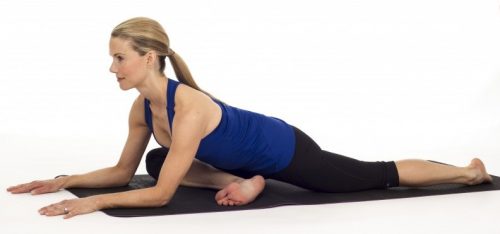 This is another stretch that will feel really good as it stretches the rotators on the outside of the hip that get really tight with an APT. Going over these muscles on the outside hip area with a foam roller can feel great as well.
This is another stretch that will feel really good as it stretches the rotators on the outside of the hip that get really tight with an APT. Going over these muscles on the outside hip area with a foam roller can feel great as well.
Hit this stretch for 3 sets on each leg holding the pose for about a 20-second moderate stretch.
Back Arches
This stretch will help you with your mobility in the lower back which is generally very tight and immobile in people who have an anterior pelvic tilt.
Perform this exercise for one set of 5 reps with 3-5 seconds hold. Do not arch to the point of pain or discomfort, keep in mind, you likely won’t be able to arch as far as the girl pictured above.
Use the Pelvic Clock
If you are looking for a device that can help you stretch, strengthen and realign your lower back then the Pelvic Clock is also something to consider. This half sphere-shaped tool will deliver amazing stretches and strengthening routines that will help with your rotated pelvis and will feel wonderful. See a small sample of it in action in the video below.
That covers the best stretches for the anterior pelvic tilt, those should have you feeling better and a lot more loose and limber. Doing the stretches alone likely won’t fix the problem. We also need to do some exercises to strengthen those weak muscles that are making this problem happen.
Best Exercises to Fix an Anterior Pelvic Tilt
Apart from stretches, there are also several exercises you can perform to help get rid of your anterior pelvic tilt problem. Here are the best exercises:
Pelvic Tilt Exercise
This exercise is effective at strengthening the deep abdominal muscles that help pull your pelvis back up into position. Make sure you rotate that pelvis up and press the low back against the floor and hold.
Hold the position for about 10 seconds then repeat three sets so that you can achieve great results.
Perform 15 reps for 3 sets on this exercise.
Bird Dog
Bird dogs are a great exercise for your entire core and glutes. When you perform this exercise make sure your back is nice and flat. No saggy backs allowed, make sure you engage your core and keep your pelvis rotated into the neutral position as well.
Perform 20 reps alternating from side to side for 3 sets.
The Glute Bridge
The exercise targets the glutes and hamstrings really well if you do it right.
Make sure you are really mentally focused on hitting the glutes when you perform this exercise, it may take a little more concentration then you would think to really get your glutes firing rather than letting the hamstrings do all the work which can be easy to do on this exercise. Focus on those glutes!
As you get stronger at this exercise you can also do it using only one leg to make it more difficult or you can place weight on your pelvic area to increase the difficulty.
The exercise should be repeated for about 20 reps for 3 sets.
The Plank
The plank is a good exercise that hits the inner abs that are so important when it comes to anti-flexion and good posture.
Start by lying face down on the exercise mat. Place your hands on the mat elbows should be directly under your shoulders. Tighten your thigh muscle as well as the stomach muscles. Lift the upper body and your thighs off the ground.
Make sure your back is straight the entire time, no sagging. Also be sure to keep that pelvis rotated up to the neutral position.
If regular planks get boring (trust me, they will) feel free to step it up with these plank variations to kick it into high gear.
Hold the plank position for about 60 seconds or as long as you can with a flat back and good form, perform 3 sets
Dead Bugs
The dead bug is another good exercise that hits the abs and the internal and external obliques.
To perform the exercise you need to lie down on your back. The knees should be bent facing upwards. Draw in the belly button and push your lower back against the floor as you engage the core and the abdominals group. If this is too easy for you then you also use a med ball for added difficulty as in the video above.
Perform 20 reps on each side for 3 sets.
Stretches and Workout Summary
The Stretches
Perform these every day for best results.
- Hip Flexor Stretch – hold for 30 seconds – 2 minutes per side for 3 sets.
- Quad Stretch – Perform 3 – 30-second stretches per leg
- Child’s Pose – hold this pose for at least 30 seconds, repeat 3 times
- Pigeon Pose – hold the pose for 2 seconds, perform this for 3 set on each side
- Back Arches – Perform this exercise for one set of 5 reps with 3-5 seconds hold on the arch. Do not arch to the point of pain or discomfort (Skip this one if you are unable to do it without discomfort.
The Exercises
Perform these at least 2 times per week, preferably 3 for best results
- Pelvic Tilt Exercise – Perform 15 reps for 3 set
- Bird Dogs – Perform 20 reps alternating from side to side for 3 sets
- Glute Bridges – 20 reps for 3 sets (use one leg or weights on your pelvis if they get too easy)
- Planks – Do 3 sets for max time up to one minute. Use these plank variations to keep it from getting boring and make it more challenging
- Dead Bugs – Perform 20 reps on each side for 3 sets
Prevention Tips
There are several actions you can take to prevent the formation of anterior pelvic tilt. Here are some of the steps you can take to prevent the health complication from affecting
you:
- Avoid Sitting for Long Periods of Time, use a raised desk if you need to do desk work
- Take the right Posture When Sitting if you must sit
- Engage in Physical Activities
- Do not sleep belly down, this only makes your pelvic tilt worse and will give you back pain in the morning. Sleep on your side instead.
Conclusion
We have given you some great stretches that should help your anterior pelvic tilt a great deal. You will likely need to perform these every day for a few months to help you get loosened up. Many people do the stretches several times a day to reduce back pain, stay loose and get a faster result.
The stretches won’t be enough on their own though, you will need to do the exercises as well. You should perform the exercises 2-3 times per week for optimal results.
Fixing an anterior pelvic tilt isn’t easy but like anything else in life, it can be done with hard work and persistence.

